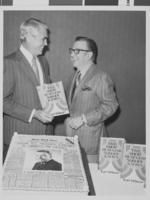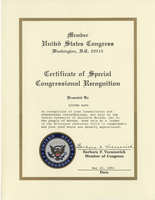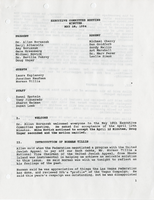Search the Special Collections and Archives Portal
Search Results

Photograph of Mayor Oran K. Gragson (left) with author Earl Wilson, circa 1971
Date
1969 to 1972
Archival Collection
Description
Las Vegas Mayor Oran K. Gragson (left) with author Earl Wilson. Mayor Gragson is holding a copy of Earl's book, The Show Business Nobody Knows. A large cake decorated as a newspaper announcing the publishing of the book sits on the table in front of them. The location where the photograph was taken is unknown. Oran Kenneth Gragson (February 14, 1911 – October 7, 2002) was an American businessman and politician. He was the longest-serving mayor of Las Vegas, Nevada, from 1959 to 1975. Gragson, a member of the Republican Party, was a small business owner who was elected Mayor on a reform platform against police corruption and for equal opportunity for people of all socio-economic and racial categories. Gragson died in a Las Vegas hospice on October 7, 2002, at the age of 91. The Oran K. Gragson Elementary School located at 555 N. Honolulu Street, Las Vegas, NV 89110 was named in his honor. Earl Wilson (May 3, 1907–January 16, 1987), born Harvey Earl Wilson, was an American journalist, gossip columnist and author, perhaps best known for his nationally syndicated newspaper column, It Happened Last Night. Wilson's column originated from the New York Post and ran from 1942 until 1983. His chronicling of the Broadway theatre scene during the "Golden Age" of show business formed the basis for a book published in 1971, The Show Business Nobody Knows. He signed his columns with the tag line, "That's Earl, brother." His nickname was "Midnight Earl". In later years, the name of his column was changed to Last Night With Earl Wilson. In his final years with the Post, he alternated with the paper's entertainment writer and restaurant critic, Martin Burden, in turning out the column. (Burden, who died in 1993, took over the Last Night column full-time upon Wilson's retirement.) Wilson is also the author of two controversial books, Show Business Laid Bare, and an unauthorized biography of Frank Sinatra, Sinatra – An Unauthorized Biography. The former book is notable for revealing the extramarital affairs of President John F. Kennedy.
Image

Photograph of the Jarva Tunnel Borer used on the Las Vegas River Mountain Project, Las Vegas, Nevada, circa 1968-1971
Date
1968 to 1971
Archival Collection
Description
Two unidentified men are examining the side view of the Jarva Tunnel Borer's cutter head. The first stage of construction was completed between 1968-1971, and is comprised of a main aqueduct, a 3.78 mile tunnel through the River Mountains, eight pumping plants, and 31.4 miles of pipeline. This stage has a peaking capacity of 26.7 million cubic feet of potable water per day. The second stage enlarged the first stage system by expanding some of the existing facilities. New features included five pumping plants, the second barrel to the main aqueduct, and about 30 miles of pipeline and laterals with surge tanks, regulating tanks, and other delivery facilities. In conjunction with this stage, the State of Nevada enlarged and modified the Alfred Merritt Smith water treatment facilities to accommodate additional water supplies. The River Mountains Tunnel was constructed to full capacity in the first stage, and the Saddle Island intake facilities were oversized to accommodate both stages. The aqueduct system has a peaking capability of 53.4 million cubic feet of water per day. The River Mountains Tunnel was constructed during the first stage to accommodate second stage expansion. It is 3.78 miles long and was excavated through the River Mountains, which lie between Las Vegas Valley and Lake Mead. The concrete-lined tunnel has an inside diameter of 121.5 inches, and a maximum capacity of 608 cfs. The SNWA also constructed a larger tunnel, parallel to the River Mountains Tunnel for further expansion. The River Mountains Tunnel is used to convey raw water from Lake Mead to the River Mountains Water Treatment Facility that SNWA constructed near Henderson, NV. The River Mountains Facility, which began delivering treated water in October 2002, treats up to 300 million gallons of water per day, and was designed so it can expand to meet Southern Nevada's needs. In the future, the River Mountains facility will be able to treat up to 600 million gallons of water a day. This facility provides additional reliability and capacity to Southern Nevada's municipal water treatment and distribution capabilities.
Image

Photograph of the tunnel looking back on stationing from 394-00 on the Las Vegas River Mountain Project, Las Vegas, Nevada, circa 1968-1971
Date
1968 to 1971
Archival Collection
Description
A view of the tunnel looking back on stationing from 394-00. The first stage of construction was completed between 1968-1971, and is comprised of a main aqueduct, a 3.78 mile tunnel through the River Mountains, eight pumping plants, and 31.4 miles of pipeline. This stage has a peaking capacity of 26.7 million cubic feet of potable water per day. The second stage enlarged the first stage system by expanding some of the existing facilities. New features included five pumping plants, the second barrel to the main aqueduct, and about 30 miles of pipeline and laterals with surge tanks, regulating tanks, and other delivery facilities. In conjunction with this stage, the State of Nevada enlarged and modified the Alfred Merritt Smith water treatment facilities to accommodate additional water supplies. The River Mountains Tunnel was constructed to full capacity in the first stage, and the Saddle Island intake facilities were oversized to accommodate both stages. The aqueduct system has a peaking capability of 53.4 million cubic feet of water per day. The River Mountains Tunnel was constructed during the first stage to accommodate second stage expansion. It is 3.78 miles long and was excavated through the River Mountains, which lie between Las Vegas Valley and Lake Mead. The concrete-lined tunnel has an inside diameter of 121.5 inches, and a maximum capacity of 608 cfs. The SNWA also constructed a larger tunnel, parallel to the River Mountains Tunnel for further expansion. The River Mountains Tunnel is used to convey raw water from Lake Mead to the River Mountains Water Treatment Facility that SNWA constructed near Henderson, NV. The River Mountains Facility, which began delivering treated water in October 2002, treats up to 300 million gallons of water per day, and was designed so it can expand to meet Southern Nevada's needs. In the future, the River Mountains facility will be able to treat up to 600 million gallons of water a day. This facility provides additional reliability and capacity to Southern Nevada's municipal water treatment and distribution capabilities.
Image


Interview with John Frederick Campbell, July 23, 2004
Date
2004-07-23
Archival Collection
Description
Narrator affiliation: Operations Mining Superintendent, Reynolds Electrical and Engineering Company (REECo)
Text

Interview with Charles Costa, February 13, 2009
Date
2009-02-13
Archival Collection
Description
Narrator affiliation: Public Health Service (USPHS), Environmental Protection Agency (EPA); Test Director, Los Alamos National Laboratory
Text
Sondra Cosgrove (Vote Nevada) oral history interview conducted by Magalena Martinez and Elia Del Carmen Solano-Patricio: transcript
Date
2023-01-20
Archival Collection
Description
From the Lincy Institute "Perspectives from the COVID-19 Pandemic" Oral History Project (MS-01178) -- Community organization interviews file.
Text
Audio recording clip of interview with Faye Todd by Claytee D. White, October 15, 1996
Date
1996-10-15
Archival Collection
Description
Part of an interview with Faye Todd by Claytee White on October 15, 1996. Todd discusses how she came to work for the Landmark and what it was like to work with entertainers.
Sound
Pagination
Refine my results
Content Type
Creator or Contributor
Subject
Archival Collection
Digital Project
Resource Type
Year
Material Type
Place
Language
Records Classification


